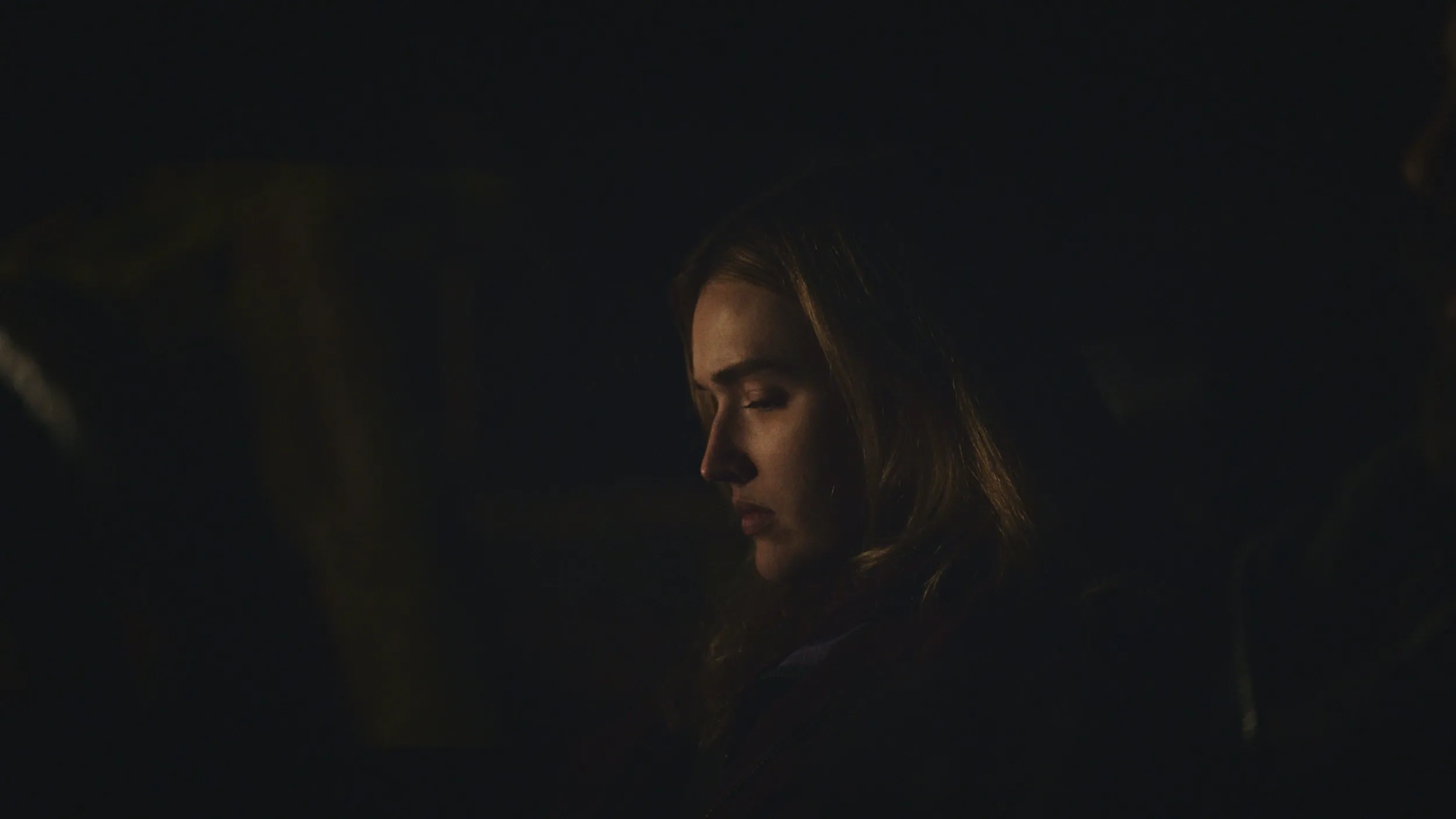Deep in an Oregon woodland lies a remote cabin, home to a solitary man who prefers isolation to company. One snowy day, through the bare trees, he makes a discovery that will alter his solitary ways—a young girl, unconscious in the forest. Thus begins the story of To Kill a Wolf, director Kelsey Taylor’s introspective retelling of Little Red Riding Hood.
Wrapped in the melancholy tones of folk music, Taylor explores complex human emotions beneath the fable’s familiar surfaces. The Woodsman, as our reclusive hero is known, nurses Dani back to health yet remains wary of entanglements. Both harbor private pains and choose solitude as refuge. Their developing friendship feels hard-won against such guarded instincts.
Through nonlinear flashbacks, we learn what drove each to seek solace in the woods. And their tales, when revealed, surprise far more than any wolf encounter ever could. With compassion for troubled souls, Taylor probes how past acts both intentional and not still shape our present. Her reshaped fairy tale plays not only on our genre expectations but seems to say mercy matters more than villainy in mending broken lives.
In this quiet forest drama, secrets surface less as twists than humble truths. And amid mysteries not yet solved, a glimmer shows that even the most wounded souls may find comfort in each other.
The Wounded Souls
To Kill a Wolf gradually unveils the intimate stories dwelling within its two central characters. Found unconscious in a snowy Oregon forest, Dani is rescued by the solitary Woodsman, who lives off the land in quiet removal from society. As Dani recuperates, neither offers many details on why they’ve come to seek isolation in the woods.
In pieces throughout its nonlinear tale, we learn that dark secrets and past trauma have long guided their steps to this remote place. The Woodsman hides the reason for his lonely lifestyle and missing leg beneath gruff grunts. Dani remains tight-lipped about what drove her to flee through the forest in distress. Only in subtle hints and glimpses do we start to understand the inner wounds that led each wounded soul to the forest.
The unfolding of their secret pains enhances our empathy. Through gently unfolding flashbacks, Taylor ensures revelations arise not as plot “twists” but as quiet truths. We see how the Woodsman came to view the community with distrust after a shattering betrayal of faith. In Dani too, a young life has borne more darkness than anyone her age should know.
The film finds symbolism in the trapped wolves the Woodsman works to save, drawing parallels to his own inability to forgive past errors that caged his spirit. Like the snared animals, the inner wounds of these characters remain in some ways beyond their control to heal. Their meeting in the woods feels destined, two damaged souls glimpsing solace in one another.
To Kill a Wolf excels at voicing the eloquence found within those silenced by private agonies. Its unconventional chronology surfaces the psychological depth dwelling behind outwardly stoic personas. In the lonely rituals that occupy their remote lives, director Taylor locates poetry and the deep humanity in all who suffer alone.
Deeper Than Folklore
To Kill a Wolf delves below the surface charms we expect from fairy tales into more profound realms. Secrecy and hidden pains are entrenched themes, as both Dani and the Woodsman carry private torments that isolation protects yet also imprisons them within.
Through intimate flashbacks, Taylor explores how past traumas blight innocence and shape our present. With quiet grace, the film acknowledges life’s capacity for darkness yet finds hope where fellowship offers solace. Their developing trust displays compassion’s power to redeem even the most withdrawn of souls.
Subtly, the narrative deconstructs preconceptions of safety and forces us to reexamine just whom we consider “villains.” Familiar folklore comforts are upturned, reality proving more complex as inner demons often prove closest to home. A stirring critique of blind faith emerges yet balanced by optimism that troubled lives may be restored through mercy over maliciousness.
The director resists overt dramatization, sensing wounded hearts heal best where feelings find expression, not exploitation. Her gentle hand grants catharsis in sparse moments of emotion, the silent company of another proving balm as profound as any sermon.
To Kill a Wolf locates life’s deeper truths amid stillness rather than noise. It confirms sorrows entangle all, yet the solidarity of small acts may light darkness’s grip. A work both grimly insightful and radiant with hope, it shows within humankind’s frailty a glow capacity for Grace as strong as any mythology.
Beneath the Folktale surface
To Kill a Wolf draws upon familiar threads from Little Red Riding Hood yet weaves its own trail through darkening woods. Taylor borrows threadbare tokens like cloaked protagonists amid looming trees yet refashions folklore into a modern tapestry glimpsing deeper human truths.
The Woodsman and Dani inhabit roles akin to fabled woodsman and child yet display inner complexities far removed from simple archetypes. Deeper revelations surface than any wolf encounter ever foretold. Reworking themes of innocence corrupted and hiding predators where expected least, Taylor breathes new life into outdated warnings for discerning eyes.
Stripping fantasy donnings exposes realities. Folktales once masked—painful pasts now shape withdrawn souls rather than beasts alone. Secrets lurk within relationships purportedly safe while the truest allies emerge where assumed harmful. Subtly, implications critique blind faith in familiarity over attentiveness to the souls before us.
Yet for all folklore’s defamations, Taylor’s adaptation remains resonant through its focus on fellowship’s restorative powers. Perhaps hope survives not due to archetypes persevering intact but their capacity to reinvent when serving human truths anew. Through intimate glimpses into hidden lives, this modern tapestry preserves folktale’s capacity for wisdom and wonder in shadows falling freshly elsewhere.
Atmosphere and Isolation
Within To Kill a Wolf’s captivating scenes, Kelsey Taylor crafts an immersive sensory experience. Wooded Oregon provides the perfect backdrop, its snow-dusted pines and mist-shrouded valleys isolating the camera’s subjects in a vast yet intimate space.
Taylor favors tight frames that place us inside cramped quarters, sharing in the confines that shape her characters’ intimacy and withdrawal. Through cabin windows or wind-battered car screens, we glimpse the ominous edge of endless forest, emphasizing nature’s dominance over these diminished souls.
Every exquisite detail, from weathered carpets to distressed fabric, speaks of hardened lives tempered by the elements. Even the grainy Super 8 flashbacks bind us more firmly to these figures’ restless spirits. In Adam Lee’s lighting and lensing, the mundane emanates a stark poetry.
While choppy transitions dilute momentum, the interweaving vignettes impart crucial context. The layered reveals grant empathy for unspoken truths, unveiling traumas that seep into even golden autumn hues.
To reform familiar archetypes, Taylor wields atmosphere as deftly as any blade. Her vision holds us with the boundless mystery of woods persisting undimmed despite all souls who have known them. Within isolation, she breathes luminous life.
Finding Humanity Within
Ivan Martin brings compassionate depth to his stoic Woodsman, imbuing a reticent soul with poignancy through sparse flickers across his hardened face. Wounds long buried emerge not with fanfare but with intimacy, reminding us that within suffering’s silence still resides capacity for grace.
Madison Brown achieves brilliance in rarer moments, gifting Dani’s trauma moments of tender clarity cutting through surface detachment. Her own internal agonies surface not for sensationalism yet solidarity, affirming turmoil need not define the wounded.
Michael Esper is chilling precisely because his false warmth seems reassuring, subverting expectations to reveal further that betrayals often emerge from the nearest corners. Yet even in his character’s darkness glimmers humanity; no soul is fully lost to villainy.
Supporting roles like David Knell’s rancher wield power through nuance over bombast. Minor figures feel rounded rather than flattened, breathing life into each lonely spirit adrift in this brooding landscape.
Depth arises too from craftsmen off-camera, immersed yet discreet. Performances here elevate Taylor’s modest visions, stripping tropes bare to disclose souls persevering with dignity despite sorrow. Folk inherit from this film’s players renewed faith that within ourselves and one another still resides capacity to redeem even the most unyielding of shadows.
A Forest of Possibilities
Despite uneven pacing in places, To Kill a Wolf proves a haunting modern fairy tale deftly exploring shadows and light in our shared human nature. Director Kelsey Taylor strips folklore’s surface but uncovers deeper truths, inviting thoughtful reflection on life’s uncomfortable ambiguities.
Her atmospheric vision delves into loneliness, loss, and life’s capacity for redemption through connection where least expected. Crafting a vivid sensory dreamscape, Taylor gifts empathy for the private pains dwelling within society’s outskirts. She locates poetry in lives lived at nature’s silent edges, outside social rules yet bound by realities all face.
Premiering this compelling, intimate drama marked Taylor as a talent demanding attention. Admirers of psychological dramas and reimagined folklore will find much to linger on in her blended realms. While conclusions offer closure, hers wisely leave new paths conceivable, advocating mercy over certainty in souls bearing history’s scars.
In a career sure to evolve, one trusts Taylor’s discerning eye and empathetic hand will unveil richer tales of humanity prevailing over tribulations through fellowship. Her modern forest remains one holding possibilities for grace to flourish where deemed impossible, infusing dimmed hopes with light.
The Review
To Kill a Wolf
To Kill a Wolf proves a hauntingly poignant modern fairy tale, unafraid to probe life's murkiest corners yet finding resilience where hope lingers, however faint. Though uneven, Taylor's distinctive vision engages hearts and minds with a bleak yet auspicious exploration of shadows dwelling in all souls.
PROS
- Atmospheric cinematography and production design that immerse the viewer
- Thoughtful, nuanced exploration of themes like trauma, secrecy, and redemption
- Strong central performances from Ivan Martin and Madison Brown
- Intimate character Focus and development through nonlinear narrative
- Poignant modern adaptation and subversion of the Little Red Riding Hood folktale
CONS
- Uneven pacing as plot momentum shifts between acts
- Chronology jumps take some effort to follow at times.
- Brown's performance lacks emotional consistency.
- Conclusion wraps up character arcs somewhat abruptly.
- Some may find tone and pace overly somber.



















































